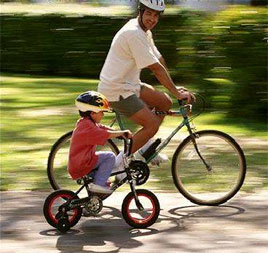 Do not push your child to ride a 2-wheeled bike without training wheels until he or she is ready. Consider the child’s coordination and desire to learn to ride. Stick with coaster (foot) brakes until your child is older and more experienced for hand brakes. Consider a balance bike with no pedals for young children to learn riding skills.
Do not push your child to ride a 2-wheeled bike without training wheels until he or she is ready. Consider the child’s coordination and desire to learn to ride. Stick with coaster (foot) brakes until your child is older and more experienced for hand brakes. Consider a balance bike with no pedals for young children to learn riding skills.- Take your child with you when you shop for the bike, so that he or she can try it out. The value of a properly fitting bike far outweighs the value of surprising your child with a new one. Buy a bike that is the right size, not one your child has to “grow into.” Oversized bikes are especially dangerous.
- Your child needs to wear a helmet on every bike ride, no matter how short or how close to home. Many injuries happen in driveways, on sidewalks, and on bike paths, not just on streets. Children learn best by observing you. Set the example: Whenever you ride, put on your helmet.
- When purchasing a helmet, look for a label or sticker that says the helmet meets the CPSC safety standard.
- A helmet protects your child from serious injury, and should always be worn. And remember, wearing a helmet at all times helps children develop the helmet habit.
- A helmet should be worn so that it is level on the head and covers the forehead, not tipped forward or backwards. The strap should be securely fastened with about 2 fingers able to fit between chin and strap.The helmet should be snug on the head, but not overly tight. Skin should move with the helmet when moved side to side. If needed, the helmet’s sizing pads can help improve the fit.
via Summer Safety Tips.
